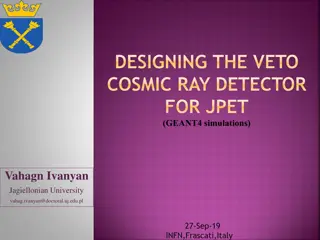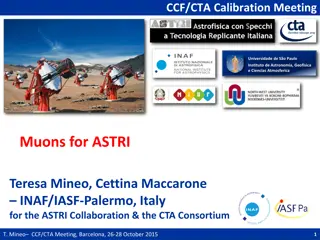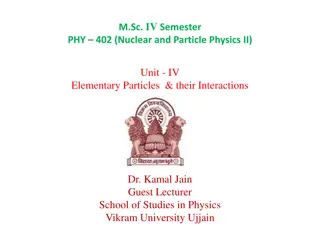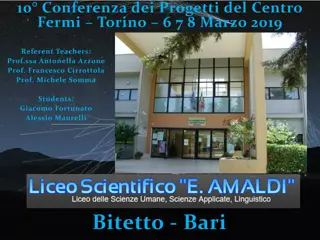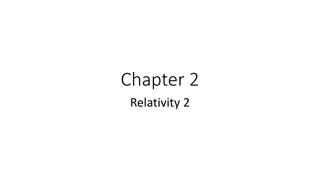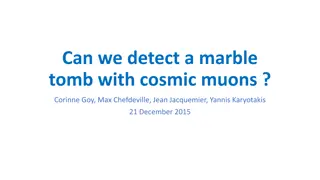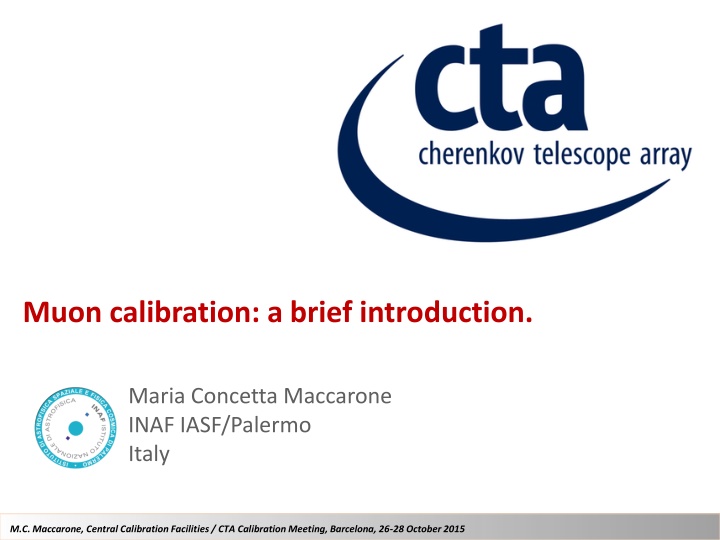
Muon Calibration: A Brief Introduction for CTA Telescopes
Explore the feasibility study on using muon rings to calibrate the total optical throughput of Cherenkov Telescope Array (CTA) telescopes, assessing viability, precision estimates, monitoring strategies, and calibration methods. Learn about the potential of muon ring analysis as the principal calibration method for CTA data.
Uploaded on | 0 Views
Download Presentation

Please find below an Image/Link to download the presentation.
The content on the website is provided AS IS for your information and personal use only. It may not be sold, licensed, or shared on other websites without obtaining consent from the author. If you encounter any issues during the download, it is possible that the publisher has removed the file from their server.
You are allowed to download the files provided on this website for personal or commercial use, subject to the condition that they are used lawfully. All files are the property of their respective owners.
The content on the website is provided AS IS for your information and personal use only. It may not be sold, licensed, or shared on other websites without obtaining consent from the author.
E N D
Presentation Transcript
Muon calibration: a brief introduction. Maria Concetta Maccarone INAF IASF/Palermo Italy M.C. Maccarone, Central Calibration Facilities / CTA Calibration Meeting, Barcelona, 26-28 October 2015
The Muons for CTA feasibility study Muon ring: a method to calibrate the total optical throughput of practically all previous IACTs. The question: Can muons be successfully used as calibrators for the various CTA telescopes? The answer: Yes, better if certain requirements are met. Details are the body of the Using Muon Rings for the Optical Throughput Calibration of the Cherenkov Telescope Array , also known as Muons for CTA document, COM-CCF/150310, result of the effort of the entire CCF-Muon group involving all the CTA telescopes teams. The Muons for CTA document is a feasibility study of the muon ring strategy for all the CTA telescopes. The study, started two years ago, is at a well advanced stage (ver.4.7) although not yet completed. 2 M.C. Maccarone, Central Calibration Facilities / CTA Calibration Meeting, Barcelona, 26-28 October 2015
The Muons for CTA feasibility study In the feasibility study, we assessing the viability to use muon images for the investigate for which telescopes the method will work, and derive estimates of the statistical and systematic precision of the method, calibration of the optical throughput, monitoring of the optical PSF, establish telescope requirements for a successful muon calibration, and derive expected event rates; monitoring the flat-fielding of the camera, and monitoring the uniformity of the mirror reflectivity propose a strategy to implement the muon calibration in the CTA data pipeline. for all the different CTA telescopes. The final outcome is that the muon ring analysis can be considered as the principal calibration method using CTA data. Moreover, to ensure the required precision, new level-B requirements for all telescopes have been suggested. 3 M.C. Maccarone, Central Calibration Facilities / CTA Calibration Meeting, Barcelona, 26-28 October 2015
Muon ring analysis as calibration method What we need? Trigger efficiency Can all telescopes trigger on (mono)-muons? LST: Not foreseen, since no previously requested; stereo muons will be used (however monitoring the stereo bias with time) Could also run the LST without requiring the LST-stereo trigger, worsen a bit the trigger threshold, but can still fulfill the required performance. Can run dedicated muon runs. All Other Telescopes: Yes but need to flag muons efficiently at level of the camera server even if they don t come along with a stereo trigger new requirement (next slides) 4 M.C. Maccarone, Central Calibration Facilities / CTA Calibration Meeting, Barcelona, 26-28 October 2015
Muon ring analysis as calibration method What we need? Trigger efficiency, Statistics The estimated muon image rates have been obtained assuming a dedicated mono trigger. A stereo trigger would reduce the rates according to the distance between telescopes. (mono) Target: extract sufficient usable muon rings from the regular data taken in less than one night (new requirements, next slide). 5 M.C. Maccarone, Central Calibration Facilities / CTA Calibration Meeting, Barcelona, 26-28 October 2015
Muon ring analysis as calibration method What we need? Trigger efficiency, Statistics It s necessary to flag muons efficiently at level of the camera server, from un-calibrated images, so ensuring that all usable estimated muon rings are written on disc even if they don t come along with a stereo trigger and at an acceptable residual (mono) cosmic rate. New requirement proposed for muon trigger B-M/SST-1300 The camera must be able to trigger on, and flag from pre-calibration data, fully contained muon rings impacting the mirror with an energy >20 GeV with an efficiency greater than 90%, even if visible in only one telescope camera. The requirement, currently under investigation by all camera teams, should not cause a problem to the currently designed telescopes and cameras. Presentations and discussion this afternoon and tomorrow morning 6 M.C. Maccarone, Central Calibration Facilities / CTA Calibration Meeting, Barcelona, 26-28 October 2015
Muon ring analysis as calibration method What we need? Spectral acceptance PMT-based cameras need to ensure that the camera becomes sufficiently opaque to light below 290 nm wavelength. This is the range where Cherenkov light from air showers is completely absorbed, but the one from muons still gets through to the camera. Cameras equipped with SiPMs will observe very similar muon and gamma-ray spectra, while Cameras equipped with PMTs will have efficiency for muon light at a wavelength range where gamma- ray showers do not emit light. A 10-30% systematic effect of the muon calibration may be expected unless the degradation of the spectral acceptance in the middle UV is monitored, or this part is cut out in its way through the optical chain. Normalized Cherenkov spectra of muons arriving from 270 m distance (green line), representative for the case of a SST, from 540 m distance (red line), representative for the case of an MST, and the Cherenkov spectrum from a gamma-ray shower emitted at 8 km above ground (blue line). 7 M.C. Maccarone, Central Calibration Facilities / CTA Calibration Meeting, Barcelona, 26-28 October 2015
Muon ring analysis as calibration method What we need? Spectral acceptance To reduce the systematic effect due to the spectral acceptance New requirement proposed B-xST-1500 The optical elements of the telescope (mirrors and camera) must be chosen such that the part of the Cherenkov light spectrum from local muons, which stems from wavelengths below 290 nm, must contribute by less than 5% to the observed muon image size, where size is understood as the sum of all photo-electrons contained in the ring image. This requirement should not cause a problem to the currently designed telescopes and cameras. Probably the LST has found a technical solution: Acrylite / ShinkoLite protecting PMMA window in front of the camera cuts exactly below 290 nm. 8 M.C. Maccarone, Central Calibration Facilities / CTA Calibration Meeting, Barcelona, 26-28 October 2015
Muon ring analysis as calibration method What we need? Chromaticity monitoring Given the different spectra of Cherenkov light from muons and gammas, un-recognized chromatic changes in the telescope elements may lead to un-recognized changes in the conversion from muon to gamma efficiency: the muon efficiency degrades, but differently to the corresponding gamma efficiency, and corrections only based on the muon efficiency may over-estimate the telescope optical throughput for Cherenkov photons from gamma showers. The incorrect estimates can reach values of the order of 13%, depending on: material of the protecting window photo multiplier quantum efficiency focused mirror reflectivity and the muon calibration without wavelength- dependent direct measurements could result (depending on the degradation time) in about 6% systematic error for the LSTs/MSTs, and 4% for SSTs. With an additional assessment of the wavelength dependency of the degradation, the precision can be improved to 3%. 9 M.C. Maccarone, Central Calibration Facilities / CTA Calibration Meeting, Barcelona, 26-28 October 2015
Muon ring analysis as calibration method What we need? Chromaticity monitoring How to define the precision with which the chromaticity of the degradation of optical elements needs to be (externally) controlled? The easiest way is with respect to a reference wavelength, e.g. 400 nm above/below which about half of the Cherenkov light falls. New requirements proposed B-xST-1600 The degradation of the optical throughput of the telescope must always be controlled such that the degradation at a wavelength measured 10 nm around 350 nm is known to better than 10% with respect to the degradation measured 10nm around 450 nm. This requirement should not cause a problem to the designed telescopes and cameras. The requirement can be fulfilled using e.g. the illuminator . Presentation and discussion this morning and tomorrow morning 10 M.C. Maccarone, Central Calibration Facilities / CTA Calibration Meeting, Barcelona, 26-28 October 2015
Muon ring analysis as calibration method What we need? Precision The feasibility of the method is related to the determination as precisely as possible of several parameters that play their essential role in the reconstruction procedure; among them: Cherenkov angle Impact parameter Muon size, total number of observed photoelectrons Local atmospheric transmission Spectral correction from Cherenkov light from muons to gamma-ray showers Some of these parameters are related to the telescopes characteristics; their knowledge contributes to answer the question: What is the precision of the method for each telescope? This is the main content of the next presentations The total systematic uncertainties achieved in the feasibility study are currently about 4%. 11 M.C. Maccarone, Central Calibration Facilities / CTA Calibration Meeting, Barcelona, 26-28 October 2015
Muons and CTA Main CCF-Muons interrelations within CTA groups OBS DATA ICDs Prod-3 MC simul. DATA TEL/Camera Servers ACTL and SWAT OBS ACTL TELs Muons MC Presentations and discussion this afternoon and tomorrow morning 1 2 M.C. Maccarone, Central Calibration Facilities / CTA Calibration Meeting, Barcelona, 26-28 October 2015
The importance of being a muon Backup Slides 1 3 M.C. Maccarone, Central Calibration Facilities / CTA Calibration Meeting, Barcelona, 26-28 October 2015
Muon ring analysis as calibration method What we need? Precision Cherenkov angle, c Impact distance, 14 1 4 M.C. Maccarone, Central Calibration Facilities / CTA Calibration Meeting, Barcelona, 26-28 October 2015
The importance of being a muon Moreover, to ensure the required precision, new level-B requirements for all telescopes have been suggested. A set of ICD has been already defined, needed for the definition of DATA pipelines. Work is in progress for some improved camera triggers. Under development are the algorithms to flag events as possible muons at level of camera server. The analysis of muon ring images can be a powerful tool to calibrate the response of a single telescope and a precision below 5% seems attainable for those telescopes providing sufficient mirror area and easily triggered images. The technique can be applied even in the relative calibration among telescopes, whenever they are not so far each another so that the same muon event be detected in two telescopes, at least. 1 5 M.C. Maccarone, Central Calibration Facilities / CTA Calibration Meeting, Barcelona, 26-28 October 2015
CCF Methods for Array Calibration: Muon ring analysis Pre-production phase To conclude the pre-construction phase: Estimates of precision to reconstruct any muon ring parameter Definition of algorithms for muon ring pre-selection, enrichment in the camera server Completion of the ICD-DATA documents Improvements of dedicated muon triggers for some specific cameras Ref. COM-TDR/140721, v. 5.1, 13 May 2015
The importance of being a muon (ring image) The importance of Being Muon (ring image) Preliminary results on the muons as calibrators We have assessed the viability to use muon images for the calibration of the optical throughput, monitoring of the optical PSF, the flat-fielding of the camera, and uniformity of the mirror reflectivity for the different telescopes currently designed for the CTA. If certain design requirements are met, like separate mono triggers, possibly adjusted to the expected shapes of muon images, and design of the telescope and camera components which ensure that the transmitted part of the muon spectrum below 290 nm becomes negligible, such a calibration scheme seems viable for all telescopes, using regular data taken in less than one night. All implementations of an SST are able to provide sufficient high-quality muon images per night and seem to be free of, or show only negligible, trigger biases. If the mirrors degradation is maintained within current requirements, muon images are adequately selected (ASTRI and GCT-M option) and a low trigger threshold is adopted (SST-1M), at least for observations of extra-galactic sources. M.C. Maccarone, CTA Consortium Meeting, Turku, Finland, May 2015
The importance of being a muon (ring image) The importance of Being Muon (ring image) Preliminary results of the feasibility study Calibration of optical throughput: for each telescope it can be calculated with better than 2% systematic uncertainty for any achromatic degradation of the optical throughput and at least on a night- per-night basis. An automatic monitoring of the muon efficiency should be implemented both for the on-site, as for the off-site analysis. Corrections to the muon calibration: The muon calibration without wavelength-dependent direct measurements will result in about 6% systematic precision for the L/MSTs (4% for the SSTs), after a long period of degradation of the optical elements. With an additional assessment of the wavelength dependency of the degradation, the precision can be improved to 2-3% again. 1 8 M.C. Maccarone, Central Calibration Facilities / CTA Calibration Meeting, Barcelona, 26-28 October 2015










